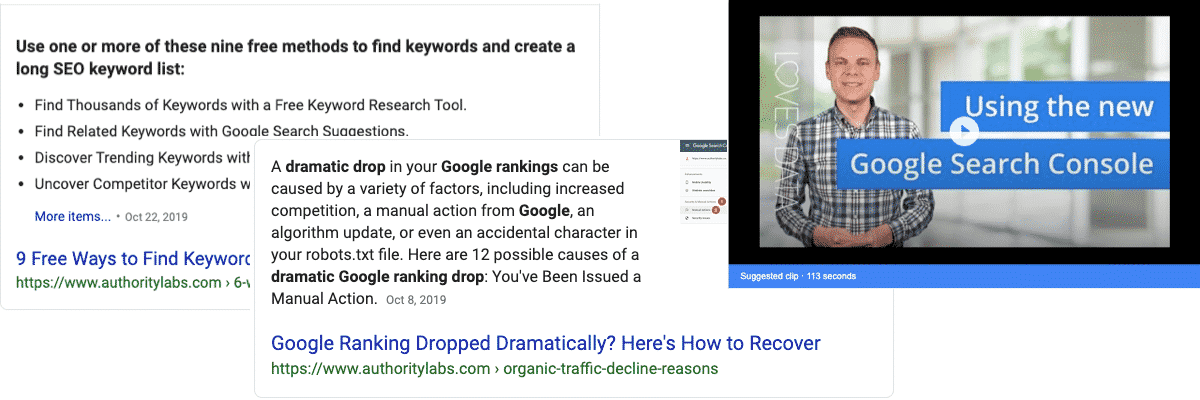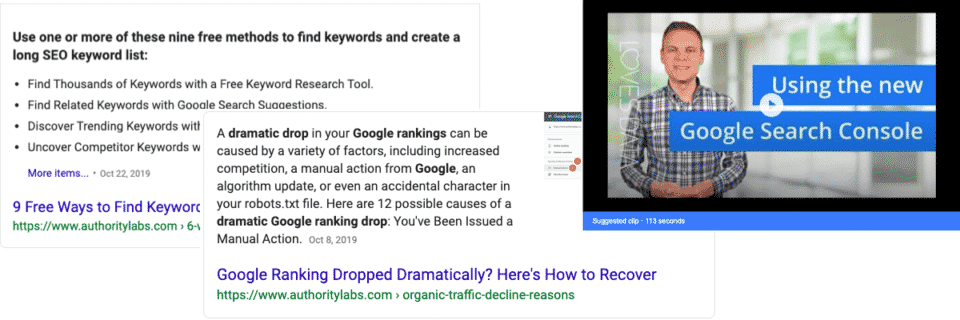I help clients update their old blog posts to regain lost clicks and organic search rankings, so a big part of what I do is optimize posts for featured snippets. After all, even if a post is ranked at the top of the ten blue links, if there’s a featured snippet from another site above it, it’s losing clicks.
So I’ve spent a lot of time this year trying to figure out exactly how to rank for featured snippets: testing different approaches, spamming Google Search Console with endless reindexing requests, and waiting with fingers crossed to find out what works.
There are a ton of guides and case studies on how to rank for featured snippets, most of which are pretty overwhelming. But from my own experience, optimizing for featured snippets is relatively simple. Just follow these seven tips.
How to Rank for Featured Snippets:
- Target Keywords That Populate Featured Snippets
- Don’t Target Featured Snippets That Won’t Generate Clicks
- Optimize Your Post Until It Ranks on Page One
- Structure Your Post Properly
- Mimic the Length and Format of Existing Featured Snippets
- Think About The Question Behind the Query
- Use Landscape Images and Write Alt Text for Them
1. Target Keywords That Populate Featured Snippets
I’ve heard tales of Google creating featured snippets that didn’t previously exist after someone created the perfect content to feature, but I’ve never actually seen that happen myself. For that reason, I’d recommend targeting keywords that are already populating featured snippets.
Not only does this approach make it clear that there is a featured snippet opportunity for that keyword, but it also makes it easier to optimize for a featured snippet when you can see exactly what type of content Google’s looking to feature.
There are a few different ways to find keywords that populate featured snippets.
Plug Your Keywords Into Google Search
A basic way to find keywords that produce featured snippets is to conduct keyword research, pick some keywords you like, plug those keywords into Google search, and see if a featured snippet appears.
If you have a long list of keywords you’re considering, start by looking for question keywords. Questions are 480% more likely to have a featured snippet. Keywords that begin with “why” questions almost always produce a paragraph featured snippet, and keywords that begin with “how” have a 52% chance of populating a list featured snippet.
Use a Keyword Tool That Surfaces Featured Snippet Opportunities
Some keyword research tools—Ahrefs, for example—let you filter a list of keywords to show only those that populate featured snippets.
This helps you narrow down your list of potential keywords to consider only those that populate featured snippets on their SERPs.
Add Your Keywords to AuthorityLabs
AuthorityLabs displays an icon next to any keyword you’re tracking if that keyword produces a featured snippet:
If you upload a large list of keywords you’re considering to AuthorityLabs, then, you can quickly scroll through the list to see which of those keywords have featured snippets.
2. Don’t Target Featured Snippets That Won’t Generate Clicks
Earning a featured snippet is fantastic—unless that featured snippet doesn’t send any traffic to your website. More than half of all search queries are zero-click searches, the result—in large part—of instant-answer SERP features like featured snippets and answer boxes.
A 2017 study by Ahrefs found that featured snippets earn, on average, 8.6% of clicks. But those numbers only hold up if people actually need to click your search result for more information. If your featured snippet fully satisfies the query, people may not click at all.
Let’s say, for example, that you’re targeting the keyword “average Twitter click-through rate.” Here’s the existing featured snippet for that keyword:
If I were searching for that keyword, that snippet might have all of the details I need. I may not be interested in clicking through to the actual result to learn about ways to increase my click-through rate because I might have just been looking for some quick benchmarks to use for evaluating my own click-through rates on Twitter.
So when you’re targeting featured snippets, think about if earning the featured snippet is going to drive clicks to your site. For the most part, this is a process of putting yourself in the searcher’s shoes and thinking about what you might be looking for if you were searching for that query.
But you can also use a tool like Moz that estimates the organic click-through rate for keywords: lower percentages mean organic results are much less likely to receive clicks.
3. Optimize Your Post Until It Ranks on Page One
Another data point from the 2017 Ahrefs study: it’s impossible to earn a featured snippet if you don’t already rank on page one of the search results for your featured snippet keyword. 30.9% of featured snippets are pulled from the number-one search result, and 90.1% are pulled from the top five search results.
The good news: you can outrank the number-one organic post with a featured snippet even if you rank organically in position five. The bad news: if you don’t rank on page one—and most likely in the top half of the page-one results—you’re not going to get a featured snippet.
So once you’ve found your featured snippet opportunities, the next step is to get your page to rank on page one. If you’re trying to get a featured snippet for an older blog post, update that post so it’s fresher, more comprehensive, and more relevant. If you’re trying to get a featured snippet for a new post, do some link building to boost your post’s rankings.
4. Structure Your Post Properly
Write your post for humans; format it for search engines.
In order to pull the content it needs to display a featured snippet, Google has to be able to understand your content. And since it’s a robot and not a human, it understands a lot through the way your content is structured.
One big mistake I see a lot of writers make is using heading tags for style rather than structure. The H2 tag doesn’t make the heading as big as they would like it to appear, so they use H1 tags for all of their headings instead. Or they have an H1 tag applied to the title of their posts but then use H3s throughout—not an H2 in sight.
This approach doesn’t diminish the experience for human readers. After all, I only know the wrong headers were used if I look at the post’s source code. But it doesn’t make sense to Googlebot because it’s only looking at your code. And if your headings are used erratically, it struggles to figure out what pieces of data it should pull to use in a featured snippet.
I’ve earned featured snippets for clients by doing nothing more than changing the heading tags used, making the structure simpler for Googlebot to understand.
H1 tags should only be used—and are typically automatically applied by your CMS—for the main title of your blog post. The main subheadings within the post, then, should use H2s. Any headings that fall under those H2s should be H3s, and any subheadings that fall under H3s should be H4s.
Here’s how headings are used in this post as an example:
5. Mimic the Length and Format of Existing Featured Snippets
I’ve read some studies that say things like “don’t write more than 50 words for the text you want to appear in a featured snippet.” But I’ve found that featured snippets tend to vary wildly in the amount of text they display from snippet to snippet.
So what I do instead is look at the existing featured snippet and try to match it’s character count and format as much as possible.
For example, if I was trying to overtake the featured snippet below…
…I would try to write a definition that was around the same number of characters (310). I copy and paste the featured snippet into Google Docs and use the word count feature to see what character count I need to aim for.
If I was trying to overtake this list featured snippet…
…I would not only include a list in my post (structured with the proper headers), but I would also introduce my list with a sentence that was about the same number of characters as the sentence that prefaces the list in the existing featured snippet.
An existing featured snippet is an example of exactly what Google’s looking for, so use that data to provide exactly what it’s looking for.
6. Think About The Question Behind the Query
While I’ve not had any luck getting Google to create a new featured snippet for a query that didn’t already display a featured snippet, I have had some luck getting Google to change the type of featured snippet that displays.
For example, I recently updated a post for a client that targeted the keyword “mind mapping benefits.” Before I updated and republished the post, the keyword populated a paragraph featured snippet. After I updated the post, the featured snippet transformed into a list snippet:
Although a paragraph featured snippet already displayed, it made far more sense for this to be a list featured snippet. After all, someone who’s searching for the benefits of something is likely looking for a list of benefits.
So while it’s good in many cases to mimic what you see in the existing featured snippet, that only really applies if the existing featured snippet provides a good answer—an answer that satisfies search intent. If you put yourself in the searcher’s shoes and decide you’d rather see a list than a paragraph, try optimizing for a list featured snippet instead and see what happens.
7. Use Landscape Images and Write Alt Text for Them
Google will sometimes include an image alongside a paragraph or list featured snippet. The interesting thing about these images is that they don’t necessarily (or even usually as far as I’ve seen) come from the featured article, and they can come from articles that don’t appear on the first page of the search results.
Google’s algorithm appears to prefer landscape images—particularly with a 4:3 aspect ratio—and you’ll want to make sure that you include descriptive alt text for any image you hope to appear inside of a featured snippet.
Be Patient, and Don’t Give Up!
I’ve seen posts I optimized for featured snippets earn the featured snippets I was targeting the very next day, and I’ve seen posts earn the featured snippets I was targeting a few weeks after updating the post and submitting it for reindexing.
So if you make a change and it doesn’t work, give it some time. A few weeks from now, you may wake up to see your URL in that featured snippet you’ve had your eye on.
Or you might not. Sometimes, you have to have to keep trying—keep optimizing and reoptimizing—to earn the featured snippet spot. I was just speaking with a colleague yesterday who was thrilled because he had finally earned a featured snippet he’d been trying to get for two months.
Finally, if you don’t want to have to search every day for the keywords you’re trying to earn featured snippets for to see if you were successful or not, consider using AuthorityLabs to track your featured snippets.
AuthorityLabs is a rank-tracking tool that updates daily to show you which positions you rank in for your target keywords and which you’ve earned featured snippets for, so you can just check one source daily to see if all of your hard optimization work has paid off with a position-zero result.

